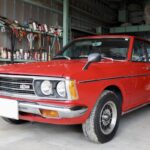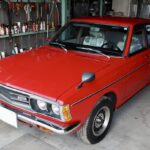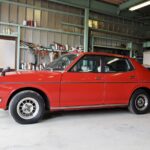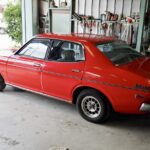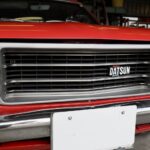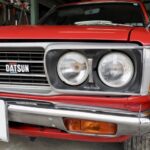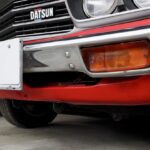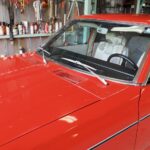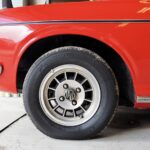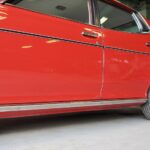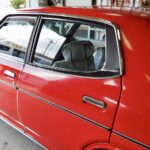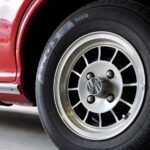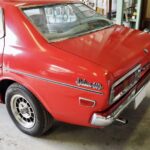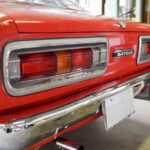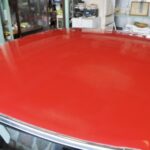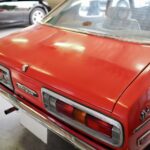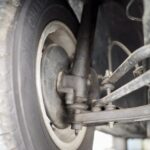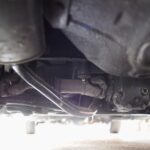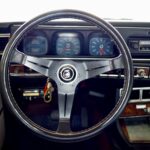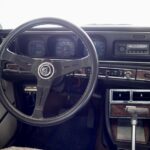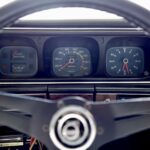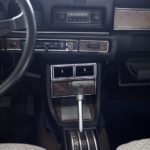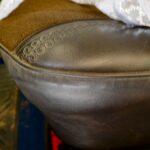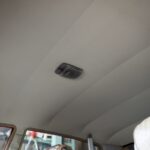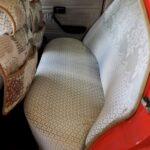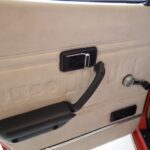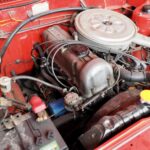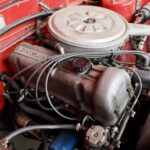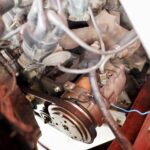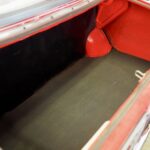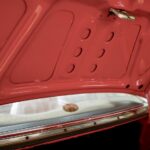TOP>Stock List>1980model MGB — Toyota 4A-G Engine Conversion / Officially Certified and Registered Vehicle
1980model
MGB — Toyota 4A-G Engine Conversion / Officially Certified and Registered Vehicle
↑↑↑Please watch the archived video above with audio if possible...
The legendary Toyota 4A-G high-revving engine from the AE86, paired with its 5-speed transmission, has completely transformed the driving character of this classic British roadster…! While preserving the authentic charm and feel of the original MGB, it now darts through winding roads with astonishing agility and precision — a seamless blend of heritage and performance. This 1980 MGB, officially certified with the 4A-G conversion, represents the ultimate evolution of a gentleman’s roadster — refined, responsive, and irresistibly alive.
The moment the key turns and the fuel-injected Toyota 4A-G engine comes alive, the air fills with a silky, finely grained mechanical sound.
A few crisp blips of the throttle, and from the familiar tailpipe emerges a tone unmistakably different from any stock MGB — a mid-range–boosted, razor-sharp exhaust note, like that of a well-tuned performance car.
As someone who has long cherished classic MGBs, I found this sound shockingly foreign to the image engraved in my memory.
In that instant, I understood completely: this is what defines an MGB reborn with the soul of Toyota’s high-revving 4A-G from the AE86 — a car that unites two nations’ engineering philosophies into one enthralling experience.
The Visionary Behind the Machine
The owner of this MGB is, quite simply, a lifelong enthusiast, a man deeply rooted in Japan’s automotive culture through his family’s long-established business.
His approach to cars goes far beyond the bounds of hobby — he conceives machines that never existed, builds them with his own vision, and goes as far as obtaining full public registration for them.
His creative energy and capacity for execution have earned him quiet renown in certain circles of Japan’s classic-car community.
His garage is a wonderland — filled with ongoing projects and relics of past achievements, a place that feels like a sanctuary for those who truly love automobiles.
It was here, over the course of four years, that he poured his heart and soul into creating this 1980 MGB — reborn with the Toyota AE86 4A-G engine and five-speed manual gearbox — the embodiment of a “British lightweight reborn for driving joy.”
The Birth of the Project
He acquired the base car — a 1980 MGB — about four years ago.
By then, the original urethane bumpers had already been replaced with chrome ones, and the car, originally red, had been fully repainted in a striking mustard yellow.
“It was the lightness of the MGB that appealed to me,” he recalls.
“The car itself wasn’t bad — but the engine was done for, nearly undrivable.
I knew it would be a big project, but I’d already decided: I’d rebuild it into the most enjoyable MGB possible.”
The heart he chose was none other than Toyota’s revered 4A-G 1.6-liter DOHC engine.
By chance, he came across a non-running AE86 donor car, purchased it, and began a full engine overhaul from the ground up.
Using the AE86’s 5-speed transmission, he rebuilt the injection system, restored the canister and blow-by recirculation systems to meet emissions requirements, and finally obtained official conversion approval (公認車検) at the Gunma Land Transport Bureau.
It was a massive effort, but the result was a legally road-registered MGB conversion, one of the very few of its kind.
Engineering the Dream
The entire process spanned over two years, with significant financial investment — but more than money, it demanded unwavering passion.
Many times he nearly gave up, but the vision of completion always pulled him forward.
The compact 4A-G now sits perfectly in a front-mid position, the driveline custom-fabricated for ideal power delivery, and the transmission placement engineered so precisely that the gearshift feels just as natural as the original.
The dashboard now houses the AE86 instrument cluster, fully functional with working indicators.
(The odometer, previously non-functional, was left as is — mileage unknown.)
“But it’s not the mileage that tells this car’s story,” he says with a grin.
“It’s the experience itself.”
Suspension and Dynamics
Determined to keep the MGB’s classic driving character, the owner retained the original lever-arm dampers and leaf-spring rear suspension.
To refine the stance, he fitted short front springs and lowering blocks at the rear — a setup that achieves the perfect balance of poise and proportion.
The pairing of the lively 4A-G and the tighter gear ratios works beautifully with this chassis, giving the car a surprisingly composed, supple behavior.
The convertible top, usually stored away as the owner prefers open-air motoring, remains in excellent condition.
The upgraded exhaust sings with enthusiasm, while vintage 14-inch Advan dish wheels complete the period-correct aesthetic.
Though the stock heater box was removed during the swap, a modern electric heater was installed — yet the familiar “MGB warmth” from the engine bay still keeps one’s feet cozy on crisp winter mornings.
“Driving early in the morning with the top down through the local mountain roads — that’s the best moment of all,” he says.
The Drive — Where Classic and JDM Meet
From a modest 80 horsepower, the old B-series engine’s output has now soared to a factory-rated 128 horsepower with the 4A-G.
At just 900 kg (measured at inspection), this MGB’s pastoral lethargy has vanished — replaced by a thrilling agility.
Through the legendary mountain passes of Haruna, Myogi, and Akagi, it dances lightly yet powerfully — the perfect union of classic grace and JDM sharpness, a drive where, as the owner puts it,
“Lightness dances, and the soul sings.”
A Dream That Never Ends
In a corner of his garage, a freshly imported Sebring-style bumper-delete kit from the UK sits unpainted, waiting in a container — a glimpse of the project’s next chapter, to be entrusted to the car’s future owner.
And as our interview drew to a close, the owner shared a final reflection:
“When you combine the MGB’s lightness with the 4A-G’s revving nature, it’s like entering another world.
The 128 horsepower feels perfectly matched — it completely transformed the car.
There’s still room for further refinement, bodywork, maybe the Sebring conversion… but I hope the next owner will continue the dream.”
This 1980 MGB 4A-G conversion is not merely a machine —
it is a manifestation of vision, endurance, and artistry.
A roadster reborn, where British soul meets Japanese precision, and the road ahead hums like a well-tuned melody.

“The Datsun Bluebird 610”… let us unravel the story of this left-hand-drive export-model car alongside the history of the Bluebird itself…
In Japan, this model was affectionately known as the “Nissan Bluebird U,” but in Okinawa during its transitional era, it was sold under its export name, “Datsun Bluebird 610”—a fact that carries with it a truly historic significance.
In 1971, Nissan introduced the Bluebird 610 as the rightful successor to the 510.
In the domestic market, it debuted as the “Bluebird U,” with the “U” standing for User Oriented—a declaration of Nissan’s focus on the customer.
The timing was the height of Japan’s rapid economic growth, when the “My Car” boom was igniting across the nation. As a car that could provide both accessibility and aspiration to the masses, the 610 played a vital role in that era.
Styling adopted the global design trend of the 1970s—the so-called “coke-bottle line”—creating a silhouette that was both sleek and powerful.
Particularly in coupe and 4-door sedan form, as seen in this example, the advanced styling was considered forward-looking for a Japanese car of the time, winning broad appeal from young people to families alike.
Under the hood was Nissan’s trusted L-series engine. This example carries the L16, a 1.6-liter inline-4 OHC producing 96 horsepower—more than sufficient for the road conditions of its day. Its sturdy construction and easy-going character laid the foundation for Nissan’s reputation as a maker of cars that “don’t break.”
True to its name as a “world-class Bluebird,” the 610 was also highly regarded internationally. In North America, it debuted as the “Datsun 610.”
With large bumpers, left-hand drive, automatic transmissions, and other features unique to U.S. specifications, it embodied Nissan’s bold spirit of global ambition.
At the same time, the 610 also made its mark in motorsport. Entering as the “1800SSS” in the grueling East African Safari Rally, it endured punishing conditions and recorded strong results. Such achievements were only possible thanks to the robust design and high base performance inherited from the 510, further solidifying the Bluebird name.
Today, while the 510 is universally remembered as an “eternal classic,” the 610 is often described as a “hidden gem.”
Yet when considering its design, its historical background, and its rare export-oriented specifications, the 610 truly stands as a symbol of Datsun in the 1970s—and deserves recognition as one of the next great and valuable Japanese classics.

Postscript to the Feature on the 1973 Datsun Bluebird 610…
The veteran owner beamed with pride as he spoke about his beloved car. Squinting slightly with sun-browned eyes from years of work, he gazed at his Bluebird and shared story after story.
This left-hand-drive, automatic Datsun Bluebird 610 is not merely an old car—it is a witness to history, one that passed through the great turning point of Okinawa’s reversion. And within the owner’s heart, I could sense a quiet turmoil: “Is it really right to let this go…?”
When I asked the simple question:
“Why did you decide to part with such a precious machine?”
He smiled and answered:
“Because everyone goes through different stages in life.”
The decision to part with it has already been made.
Yet, it seems that only when he meets a sincere new owner—someone to whom he feels he can truly entrust it—will that decision transform into a heartfelt resolve.
Ultra-rare…! This left-hand-drive, automatic Bluebird 610—delivered new to Okinawa just after its reversion—was fully repainted and given a complete engine overhaul under the care of a devoted enthusiast, transforming it into a car that truly tells its own history…!
This Bluebird 610 is not just an old car—it is a living witness to history, embodying the era of Okinawa’s reversion. Even after half a century, its presence has not faded, and it remains a car that truly deserves to be passed on to the next generation…
For a truly special and romantic viewing of this one-of-a-kind machine…
please come to Gunma Prefecture…
This very rare 1973 Datsun Bluebird 610 is currently located in Gunma Prefecture, Japan.
As this is a private sale, there will be no consumption tax or additional fees.
Upon purchase, the buyer will be responsible for the prorated automobile tax (annual amount: ¥45,400) as well as the recycling deposit settlement (¥0, as it has not been prepaid).
Transportation arrangements will be the responsibility of the buyer; however, through my own business I also provide classic car transport services using a company-owned carrier truck. Should you wish, please feel free to consult with me regarding delivery.
[For Inquiries…]
This vehicle is listed on the cross-border EC site for classic and collectible cars, Estate Sale Supremacy®.
What is Estate Sale Supremacy®?
It is the Japanese interpretation of the North American “Estate Sale” culture—introducing cherished cars through articles and videos based on in-depth owner interviews. We faithfully convey the owner’s feelings, ensuring memories remain in the heart while reliably guiding the vehicle into the hands of the next generation, including full support for sales brokerage.
We conduct detailed interviews with current owners covering maintenance history, repairs, and any accident records. If a vehicle has a serious accident history, or if the owner’s period of possession is extremely short and details cannot be clarified, we decline to feature it—our effort to provide prospective buyers with the greatest possible peace of mind.
This article was written following a three-hour interview and on-site inspection of the vehicle on August 1, 2025, starting at 11:00 a.m. under clear skies. Please note that because of the limited inspection time, the condition described here may not represent 100% accuracy, and not all details have been independently verified. Comments regarding condition are based on the weather, circumstances, and the author’s personal impressions at the time of the interview.
For questions regarding the listed vehicle or to request a viewing appointment, please contact us via the form at the bottom of this page.
As this is a private transaction, please understand that vehicle viewings are strictly limited to customers who are seriously considering purchase, in order to prevent casual inquiries.
We sincerely thank you for your consideration.







